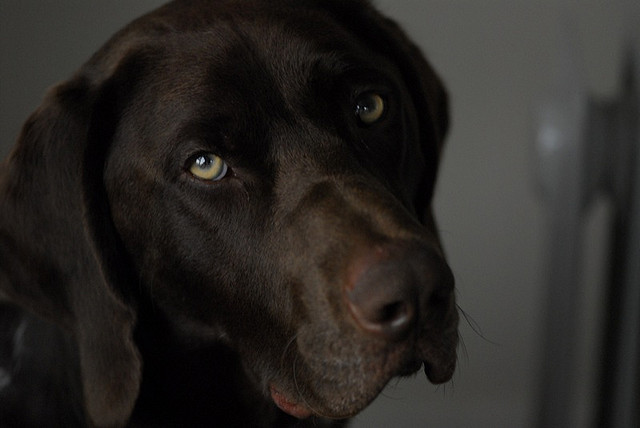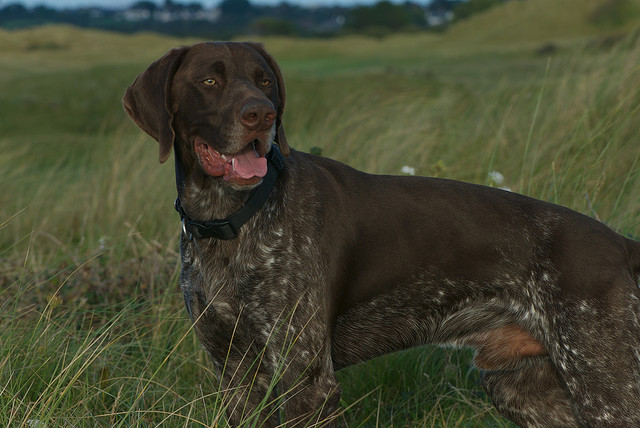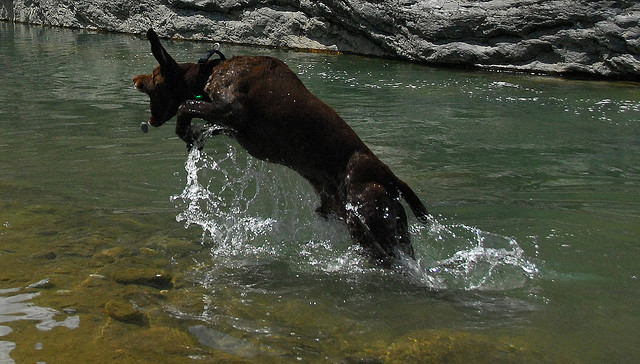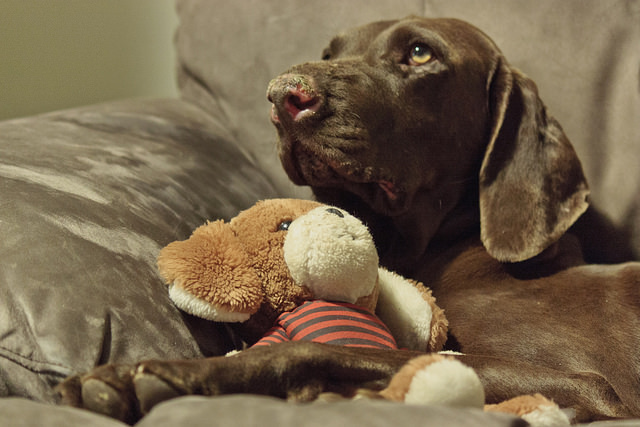Often known as the GSP, the Deutsch Kurzhaar, the Kurzhaar and the Deutsher Kurzhaairger Vorstehhund, the German Shorthaired Pointer is an intelligent, energetic breed of dog that enjoys being a companion to humans. These dogs also love working and have plenty of energy. They require plenty of physical and mental stimulation to keep them from getting bored and getting into trouble. Since they have hunting instinct, they usually need to be trained that small animals, birds and cats are not their prey.
Origin
There is little information on the origin of this breed before the formation of the Klub Kurzhaar Stud Book, which wasn’t formed until the 1870s. However, it’s obvious that German hunters spent quite a bit of time breeding these dogs to be obedient and versatile. It’s thought that the early German Shorthair Pointers probably descended from local scent-hounds in Germany, the Spanish Pointer and the German Bird Dog. It wasn’t until the late 1800s and the early 1900s that the German Shorthair Pointer was finally refined to a breed that had scenting skills, keen intelligence and a refined, elegant style and stance. By selective breeding, including crossing the dogs with the English Pointer, breeders were able to eliminate the breed’s lack of aggression towards prey and the breed’s aversion to water.
It wasn’t until the early 1900s that the breed was welcomed in the United States, and the GSP became quite popular among American sportsmen. Today the breed continues to be very popular and they are still used to flush and hunt partridge, rabbits, possums, quail, raccoons, duck, grouse and other small game. This breed is popular in the show ring and often takes part in field trial championships.
Appearance
German Shorthaired Pointers are well-balanced and lean, featured a large nose, floppy, broad ears, a long muzzle and almond-shaped, expressive eyes. They are a little bit smaller than standard pointers and their occipital bone is not quite as pronounced. They have a sleek, dense, short coat that may be solid liver colored (brown) or in roan (an even mixture of white and pigmented hairs), ticked (spots of black hairs on a white areas) or patched. The coat is also water resistant and the coat is longer at the haunches and on the underside of their tail. The tail of this breed is docked when they are small by 60% and the dewclaws are also removed. Since they feature webbed feet, they are wonderful swimmers.
Males are usually 23 to 25 inches high at the withers and the females usually are 21 to 23 inches high. A male German Shorthaired Pointer normally between 55-70 pounds, while the females are a bit lighter and usually weigh between 45-60 pounds.
Temperament
The German Shorthaired Pointer was bred to be a hunting dog, but they are also loving companions that do well with families. These dogs love being outdoors with the family and they are wonderful with kids as well. They are also great watchdogs and they will bark when someone approaches the property. While they bark, they simply bark to alert owners of an approaching person – their bark isn’t aggressive.
Since the breed is so people-oriented, separation anxiety is a common problem. They become very attached to their family and may become depressed if they are left alone. This anxiety often comes out through excessive barking, digging and chewing. Although these dogs are wonderful with people, they don’t do well with small dogs or cats, since they may have the desire to chase them. Males may also display aggression towards male dogs, so it’s best to only bring a female dog into the home if you plan to have another dog.
While the German Shorthaired Pointer picks up on hunting commands fast, they can be difficult to train in basic obedience commands because they are so easily distracted by smells, sounds and sight. To train these dogs, it is important to have short sessions while the dog is young. Gentle, consistent positive reinforcement is essential when training this breed.
Grooming
When it comes to grooming, the German Shorthaired Pointer requires little maintenance. Since their coat is short and they shed only mildly, they do fine with only a brushing once each week. It is important to use a firm bristle brush when brushing their coat, which helps eliminate dead, loose hair while keeping their coat nice and healthy. Overbathing should be avoided, since it can break down the water repellent, natural oils in their hair. These dogs should only be bathed when absolutely needed. For a gleaming coat, a chamois can be used to rub down the coat.
Active GSPs will naturally wear down their toenails. However, if you hear the nails clicking on a hard floor, the toenails need to be trimmed. Their floppy ears need to be checked each week for wax buildup, irritation and infection. Ears can be cleaned using a cotton ball and an ear cleaning solution approved by a vet.
Working Roles
German Shorthaired Pointers love to work and hunters use them today. Not only do they perform well when hunting or flushing out small game, but hunters can also use them when hunting dangerous, larger game.
Health
Usually, the German Shorthaired Pointer lives to be 12-14 years old. While they are generally healthy, tough dogs, their breeding puts them at risk for various hereditary disorders. Some of the GSPs suffer from hereditary disorders such as genetic eye diseases, cancer, epilepsy, hip dysplasia and skin disorders. Un-spayed femal German Shorthaired Pointers are prone to develop breast cancer, although breeding the female reduces her risk.
Bloat is a common health problem found in the breed because of the deep chest. To avoid bloat, it is important to avoid feeding these dogs right after or before exercising. Several small meals should be given to GSPs instead of offering one or two large meals. Owners should make sure that these dogs do not consume too much water when they eat dry food.
Some of the other health concerns that may affect the German Shorthaired Pointer include:
- Hereditary lupoid dermatosis
- Naval cavity tumors
- XX sex reversal
- Von Willebrand’s disease
- Central diabetes
- Cleft palate
- Insipidus
- Cranial cruciate ligament rupture




